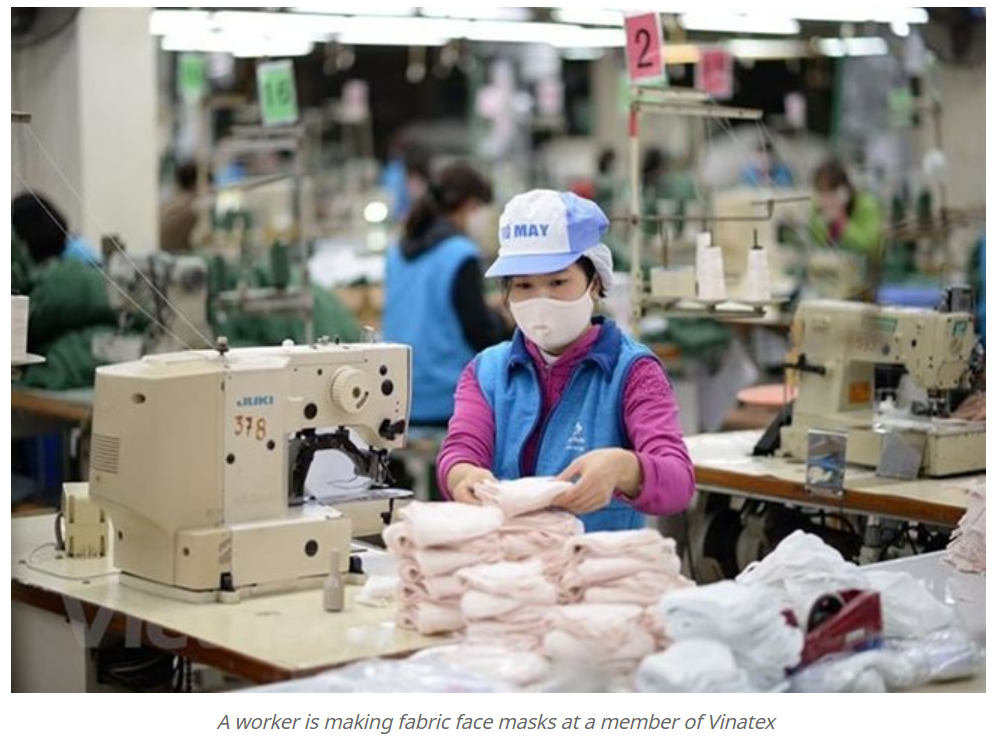Vietnam: The arduous path in exporting fabric masks
 Faced with canceled orders from importers in Europe and North America, some Vietnamese companies in this industry have switched to producing antibacterial fabric face masks.
Faced with canceled orders from importers in Europe and North America, some Vietnamese companies in this industry have switched to producing antibacterial fabric face masks.
However, the path on which made-in-Vietnam fabric face masks are sent to overseas markets remains thorny.
Viet Thang Jean, or Vitajean, has just sent its first batches of fabric face masks to the United States, Poland and the Netherlands. By the weekend, each of these countries will have received on a trial basis 20,000-50,00 fabric masks, which have three layers—the anti-droplet layer, the antibacterial layer and the skin-protection layer. Prior to these first batches, Vitajean had dispatched mask samples to receive feedback on their quality.
Pham Van Viet, Vitajean board chairman, says making fabric masks is not a problem at all for his company’s workers. The more challenging task, though, is how to meet quality and formality requirements imposed by importers. Understandably, amid the ravaging coronavirus pandemic, American and European partners have set extremely high criteria.
In order for their products to be accepted, Vitajean has had to meet meticulous conditions for quality assurance, among which is the transparency of all information on the products. For instance, Viet says, his masks must be qualified for the structure of the fabric in use, the chemical content and the anti-bacterial resistance. What’s more, each batch of products to be dispatched must be accompanied by a report on the results of anti-bacterial testing in line with the host country’s disease prevention regulations.
According to some Vietnamese mask makers, they have to surmount yet another hurdle, the Oeko-Tex Standard 100, a test for harmful substances to ensure that the article in question is harmless in human ecological terms. The complicated and time-consuming certification saga has therefore become more lengthy during the pandemic time.
Vitajean is not alone in its effort to make fabric masks. Many of their local counterparts have also temporarily resorted to fabric mask production to keep themselves alive and ensure jobs for their workforces.
Latest statistics obtained from the Industrial Department under the Ministry of Industry and Trade show that at least 50 enterprises have sent over reports on their capacity to make fabric masks. They alone claim to be able to turn out 8 million fabric masks a day, or 200 million a month. Given the much bigger number of garment firms nationwide in Vietnam, the possible overall production capacity may be significantly larger.
The tough task of securing a foothold in supply chains
In reality, the input of qualified fabric for making masks is now no longer a headache for local enterprises as it once was. Only a short while ago, all anti-bacterial fabric or chemicals needed to make such fabric masks had to be imported. However, several local companies have been able to produce anti-bacterial fabric from bio-materials available domestically. The solution to the input of materials means that domestic producers of fabric masks may make more products if they can win more orders.
However, a great deal of mask importers have insisted that the materials to be used for their orders have to comply with requirements set by them or their countries.
Viet says some of his customers demand that the materials must be imported from either South Korea, Taiwan or Japan. Meanwhile, the chemicals in use must be sent in from European countries, Japan or Thailand. This request suggests that in reality, the only phase where Vietnamese mask makers can be active is… the production phase.
Furthermore, each importing country has her own standards for each specific product. To cope with this problem, local mask producers have sought help from Vietnamese diplomatic corps, especially trade commissioners in foreign countries.
Another obstacle, according to Viet, is social distancing and lockdown measures being effective in importing nations. Currently, flights have been mostly discontinued, making goods transportation extremely painful, he says.
Above all, the hardest nut to crack for Vietnamese fabric mask makers, says Viet, relates to the habit of using face masks in American and European nations. As surgical masks are traditionally in use in these countries, fabric masks need time to gain ground.
Officials from the Ministry of Industry and Trade have maintained that considering the capacity of the local textile and garment industry, local enterprises may transform Vietnam into a big fabric mask exporting nation.
However, these officials also warned that to make fabric masks more popular in the world, promotional campaigns must be conducted. Another cause for concern, they said, is the escalating demand for fabric masks during Covid-19 would significantly decline once the pandemic is over. So, this product should be considered an interim measure, and costly long-term investment in it should thus be made only with great care.
From the corporate perspective, Viet shares the above warning. He says about a dozen of his American and European customers have been actually interested in his fabric masks. However, Vitajean has not yet pinned high hope on this kind of products in the long run.
“What we are doing with fabric mask production right now is giving jobs to our workers,” he says, adding that it is a way to keep his workers active while waiting for the pandemic to come to an end. The sustainability of fabric masks needs more time for further assessment, Viet contends. SGT
Hung Le
Source: https://vietnamnet.vn/en/business/the-arduous-path-in-exporting-fabric-masks-637225.html


 Thailand
Thailand




